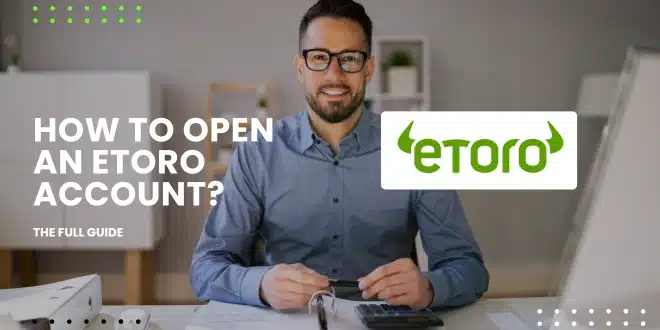Opening an eToro account is your first step toward joining one of the world’s most beginner-friendly trading platforms. Whether you’re looking to trade stocks, crypto, ETFs, or try out copy trading, eToro gives you access to a wide range of assets with a user-friendly interface and a global community.
This step-by-step guide explains how to open an account on eToro, what documents you’ll need, how long it takes, and how to avoid common mistakes based on real user experiences.
Step 1: Go to the eToro Website or Download the App
You can start the process from your computer or your phone.
- On desktop, go to www.etoro.com
- On mobile, download the official eToro app from the App Store or Google Play
Make sure you’re on the official site or app to avoid phishing scams. Look for the lock icon in the address bar if you’re using a browser.
Step 2: Create Your Account
When creating your eToro account, you’ll first be asked to choose a username and password, along with your email. Try to choose a unique username that you’ll remember, and use a password that includes letters, numbers, and symbols. After agreeing to the terms and conditions, your account is created.
If you use Google or Facebook to sign up, it can speed up login — but make sure those accounts are secure too. Also, note that signing up does not mean your account is verified — you’ll still need to go through the KYC steps before you can start trading.
Step 3: Verify Your Identity (KYC Process)
This process is required by global regulators to make sure every user is who they say they are.
- Proof of Identity (POI): Use a clear photo of a passport, government-issued ID, or driver’s license. Make sure the entire document is visible, including all corners.
- Proof of Address (POA): Upload a bank statement, utility bill, or tax letter that’s no older than 3–6 months. Ensure your full name and address match the details you entered during registration.
Uploading high-quality scans or photos in good lighting speeds up the process. Verification may take 1–3 business days depending on demand.
Step 4: Complete the Questionnaire
This short form evaluates your experience level and ensures compliance with local financial regulations.
You’ll be asked questions like:
- How many years you’ve been trading
- What instruments you’re familiar with (e.g., stocks, crypto, CFDs)
- What your typical trade size might be
Your answers won’t block you from opening an account, but they might influence which products eToro makes available to you. For example, if you say you’ve never traded derivatives before, you may have limited access to leveraged instruments at first.
Step 5: Set Up Two-Factor Authentication (Optional, but Recommended)
2FA adds a second layer of login security beyond just your password. After turning it on in your eToro settings, each time you log in, you’ll enter a 6-digit code generated by your phone or authentication app. This helps protect your account even if someone gets your password. If you lose your phone, you’ll need to contact eToro support to recover access, so back up your codes when prompted.
Step 6: Make Your First Deposit
After your documents are verified, you can fund your account. eToro supports:
- Bank transfers
- Credit/debit cards
- PayPal
- Skrill
- Neteller
Deposit minimums vary by region:
- In the US and UK, the minimum is usually $10
- In the EU, it may range between $50–$200, depending on method
- Other regions may have different limits — eToro will show you the minimum required
Tip: Some users report delays in bank transfers of up to 3 days. Credit card and e-wallet deposits are typically instant.
Step 7: Start Trading (or Use the Demo Account)
After depositing, you’ll land on the eToro dashboard. You can:
- Search for assets in the top bar
- Click “Trade” on any instrument to open a position
- Track your open trades in the “Portfolio” tab
If you’re not ready to invest real money, use the demo account, which comes with $100,000 in virtual funds. This lets you learn how everything works without risk.
Other eToro Account Types (Detailed Overview)
Besides the standard retail account, eToro offers several options:
- Demo Account: Automatically included, ideal for practice and learning
- Islamic Account: Swap-free account for traders who follow Sharia law. Must be requested after sign-up
- Professional Account: For high-volume traders who qualify under eToro’s criteria. Offers higher leverage but fewer protections
- Corporate Account: For businesses wanting to trade as an entity. Requires more documentation
Real User Insights: What Can Go Wrong?
- Verification Delays – Some users experience delays of up to 5 days if documents are blurry or mismatched
- Rejected Proofs – Photos that are too dark, cut off, or unclear are often rejected
- Deposit Problems – Avoid using a third-party card or bank account; deposits must come from an account in your name
Tip: Contact eToro’s live chat support if anything is unclear. Most users say responses are quick during weekdays.
FAQ
1. Can I open an account if I’m under 18? No. eToro requires all users to be at least 18 years old.
2. Can I trade cryptocurrency on eToro without verification? No. You must complete full identity verification before trading real assets, including crypto.
3. Does eToro charge an account opening fee? No. Opening and maintaining an eToro account is free.
4. What should I do if my ID gets rejected? Ensure the document is valid, not cropped or blurry, and fully shows your name and expiration date.
5. Can I open multiple accounts? No. eToro only allows one account per person, but you can use both demo and real money features in one account.
6. Can I use a business email? Yes, but ensure your name matches your verification documents unless you’re opening a corporate account.
7. How long does verification take? Usually 1–3 business days. You’ll get a notification when your account is verified.
8. Is the demo account really free? Yes. Every new eToro user automatically gets a $100,000 virtual account for practice.


